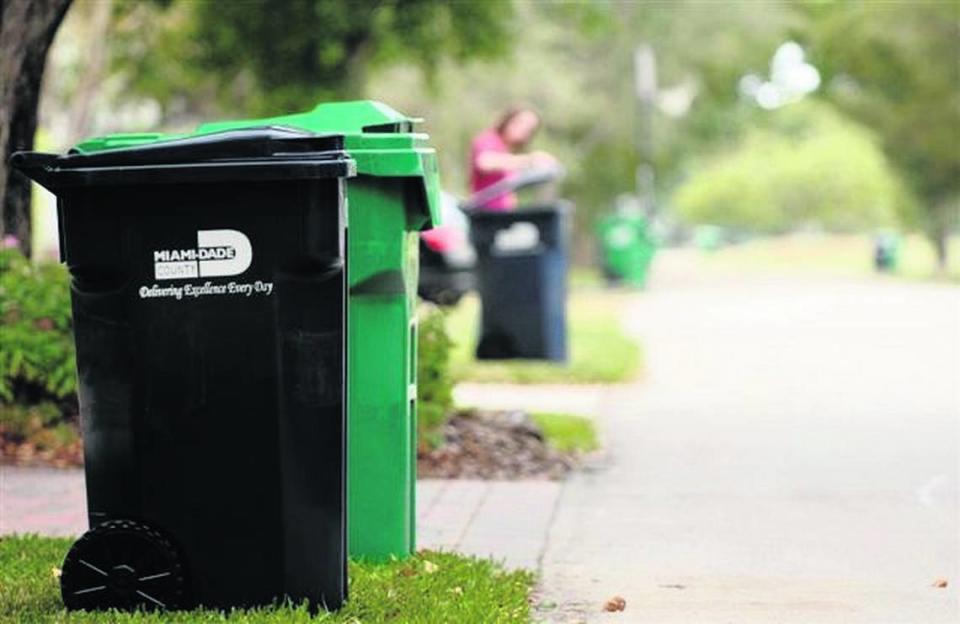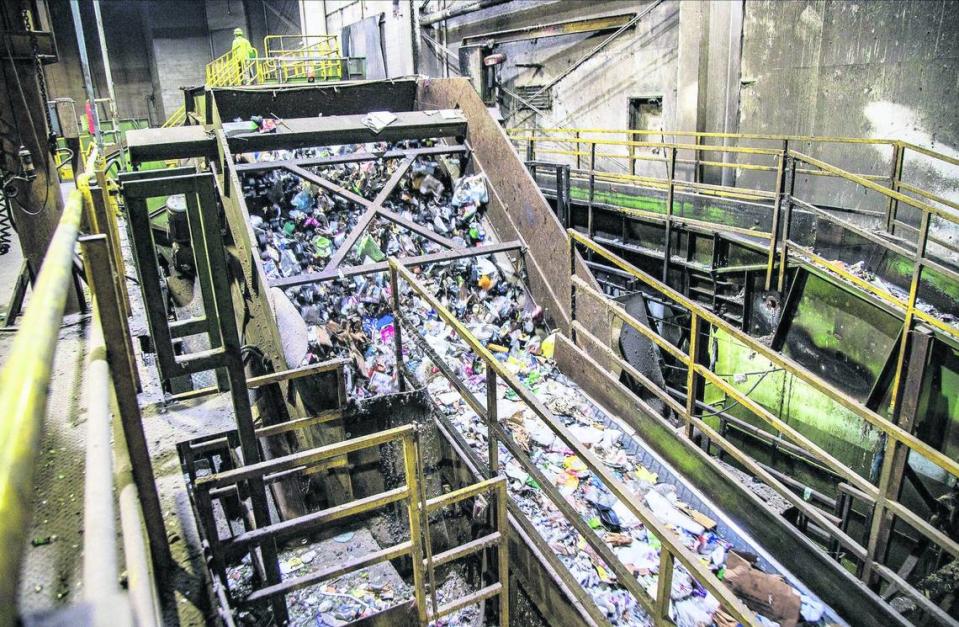Miami-Dade trash collection’s money problem could end county’s recycling program
- Oops!Something went wrong.Please try again later.
One Miami-Dade County resident said she knows people who throw all kinds of trash in their recycling bins and “hope for the best.”
These lax recycling practices Margaret Gotthold described lead to contaminated — and sometimes unrecyclable — loads of waste, which are a major strain on the county’s recycling program. Gotthold lives in unincorporated Miami-Dade.
Contamination is just one challenge the county’s recycling program is facing right now. Another is the nearly $40 million shortfall the solid waste department expects at the end of this fiscal year.
This may mean higher fees for residents serviced by the county’s recycling program. Or, as Commissioner Kevin Cabrera suggested at the last Miami-Dade County Commission meeting, cutting the county’s curbside recycling service altogether.
READ MORE: Miami-Dade’s recycling program in jeopardy as commissioners punt on fee increase
Mayor Daniella Levine Cava has recommended increasing solid waste fees by $36 a year for Miami-Dade residents to bridge the gap, and the commission is expected to vote on the matter in September.
The county provides recycling services to the more than 1 million residents of unincorporated Miami-Dade County, as well as residents of a number of cities, including Aventura, Cutler Bay and Miami Gardens. Recyclables from Miami-Dade County go to a facility in Pembroke Pines managed by Waste Management.
Fee increase will provide ‘enhanced services,’ mayor says
The county is facing a number of challenges to its solid waste program, including a fire at a Doral waste incinerator in February and globally low demand for recycling. A mayoral memo from March stated this shift in the recycling market is due in large part to a Chinese policy introduced in 2019 that banned waste imports. The U.S. had previously exported much of its recycling waste to China.
The June mayoral memo stated recycling has shifted from a “revenue-generating operation to a service municipalities must now pay for.”
Levine Cava recommended the $36 fee increase to avoid cuts that “would dramatically affect the quality of service,” the memo stated. Even with the proposed cuts, the county still would have had to raise rates to account for the shortfall.
With the $36 fee increase, Levine Cava told the Herald the county could expand its solid waste offerings. This would include improved monitoring for illegal dumping, she said.
Levine Cava said the county hopes to avoid continually raising fees for solid waste by establishing a special taxing district to fund the program. She said understands that Miami-Dade residents have become “weary and wary” of fee increases.

Residents respond to rising fees
Gotthold said she values the recycling program and does not necessarily want to see it cut over a fee increase she considers relatively small. She said she does not pay the recycling fees directly as a renter, but the county’s recycling program serves her residence. Gotthold added that she wishes she had a clearer idea of whether the program is effective and worthwhile.
Noel Cleland, who lives in unincorporated Miami-Dade near South Miami, voiced his support for the proposal at the July commission meeting. He later told the Herald keeping the county’s recycling program is worth raising fees, and he said he would accept an even greater increase if it meant a better recycling program for the county.
Cleland, who is the chair of the local chapter of the Sierra Club, added that he thinks the county should work to reduce its waste stream and improve its recycling program, which he described as “not very successful.”
Patricia Ellis was one of several Miami-Dade residents who asked the commission not to approve the higher fee at the commission meeting in July. Ellis said as a senior citizen on a fixed income, higher fees would be difficult to shoulder.
Levine Cava said she understands residents’ concerns about the rising cost of solid waste services.
“It is expensive, and we do produce a lot of waste,” Levine Cava said. “We have to work with our community to help them to reduce the cost by reducing our waste.”

Contamination rates declining, but still an issue in Miami-Dade
The contamination rate in Miami-Dade County’s recycling program has fallen from around 50% to under 40%, Levine Cava told the Herald. Though she said the county’s contamination rate has gone down in recent years, the mayor said contaminated recycling is still a concern.
Contamination occurs when individuals throw non-recyclables in their recycling bins. Contaminants can be non-recyclable types of plastic and recyclables that have food waste on them. If a load of recycling is too contaminated, it may not get recycled at all and instead go to the landfill.
Gotthold said when she moved into her current home, she received a flyer explaining what could and couldn’t be recycled, but that it was still “a bit unclear.”
Often people are not contaminating their recycling bins intentionally, Cleland said. They are either unaware of what can and can’t be recycled or hope someone at the recycling will be able to sort it out for them.
Levine Cava said programs that educate residents about what they can and can’t recycle are important in reducing the contamination rate in Miami-Dade County.
Plastic bags, which Levine Cava called “the enemy of the system,” are one of the most common contaminants in recycling loads. Cleland, who has been an environmentalist since college, encouraged Miami-Dade residents not to throw their recycling out in plastic garbage bags, which can jam up the machinery at the recycling facility.
Who is best at recycling?
Lorenzo Daetz, who supervises the solid waste program in Charlotte County on Florida’s southwest coast, said his county has a consistently low contamination rate at between 13% and 17%.
One of the most important aspects of Charlotte County’s recycling program is its education and public information campaigns, Daetz said. He said it is particularly important for the county’s recycling outreach to include low-income areas.
Charlotte County is considering implementing a new protocol for residents who consistently break recycling guidelines. Daetz said these individuals would lose their recycling privileges, but they would be able to earn them back by working with county officials to learn proper recycling practices.
READ MORE: Waste Management’s tips for proper recycling
Daetz said the county does not impose fines on its residents and does not plan to.
Pembroke Pines introduced a new waste disposal program to address contamination rates last year. Starting in January 2022, the city started sending all trash and recyclables from residences to the Wheelabrator South Broward Waste-to-Energy facility to be incinerated. According to a flyer announcing the new program, incineration is considered recycling in Florida.
A flyer from December 2021 explaining the change called this program “a more efficient, less time consuming” way to dispose of the county’s waste. Sending all refuse to the same place eliminates the risk of contamination present in traditional recycling.

